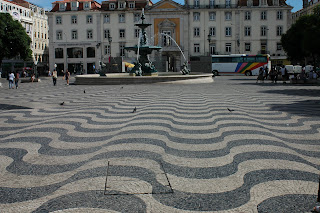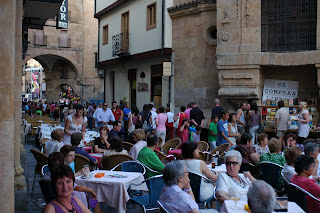 From Santa Apolonia station we took another yellow top bus to get a feel for the city. This took us past the 1998 World Expo site which had some interesting structures.
From Santa Apolonia station we took another yellow top bus to get a feel for the city. This took us past the 1998 World Expo site which had some interesting structures. This insitu concrete suspended roof is some 50 metres wide beyond which is the wall to the boat harbour and gondolas. In the far distance is the 11 kms long Vasco da Gama bridge which crosses the Rio Tejo (Tagus) joining Montijo and Sacavém.
This insitu concrete suspended roof is some 50 metres wide beyond which is the wall to the boat harbour and gondolas. In the far distance is the 11 kms long Vasco da Gama bridge which crosses the Rio Tejo (Tagus) joining Montijo and Sacavém. Lisbon suffered a substantial earthquake in 1755 so many of the buildings are relatively new with the central Baixa and Avenida areas neatly laid out in a grid pattern. Some older structures do exist such as the Castelo de Sao Jorge which was started in 1147 however much of the battlements had to be rebuilt after the earthquake.
Lisbon suffered a substantial earthquake in 1755 so many of the buildings are relatively new with the central Baixa and Avenida areas neatly laid out in a grid pattern. Some older structures do exist such as the Castelo de Sao Jorge which was started in 1147 however much of the battlements had to be rebuilt after the earthquake. The Baixa and Avenida areas comprise a series of squares between linear streets. The most central is the Rossio which is surrounded by numerous restaurants. This great view was obtained from the top of the Elevator de Santa Justa (more below).
The Baixa and Avenida areas comprise a series of squares between linear streets. The most central is the Rossio which is surrounded by numerous restaurants. This great view was obtained from the top of the Elevator de Santa Justa (more below). Apart from the conventional buses and trams Lisbon sports a couple of unusual modes of transport. These small motorised tricycles were a bit of fun. One Asian couple went past operating one handlebar each, hence one was in charge of the brakes and the other the accelerator; as for steering……
Apart from the conventional buses and trams Lisbon sports a couple of unusual modes of transport. These small motorised tricycles were a bit of fun. One Asian couple went past operating one handlebar each, hence one was in charge of the brakes and the other the accelerator; as for steering…… There was also a funicular as the Baxia area is set in a steep sided valley.
There was also a funicular as the Baxia area is set in a steep sided valley. An alternative to travelling up the valley was the Elevator de Santa Justa. This wonderful wrought iron structure was built in 1902 and initially was operated by steam converting to electricity in 1907. The two lift cars are beautiful wood lined affairs.
An alternative to travelling up the valley was the Elevator de Santa Justa. This wonderful wrought iron structure was built in 1902 and initially was operated by steam converting to electricity in 1907. The two lift cars are beautiful wood lined affairs. Continuing down towards the Tajo is the Praça do Commércio. This is vast and was quite a walk between the statue of King José I and the triumphal arch which leads up into the Baixa area.
Continuing down towards the Tajo is the Praça do Commércio. This is vast and was quite a walk between the statue of King José I and the triumphal arch which leads up into the Baixa area. The variety of some of the buildings is notable with Art Deco
The variety of some of the buildings is notable with Art Deco and the very attractive Rossio station (although no trains now operate from here) with its late 19th century Moorish style horseshoe entrances.
and the very attractive Rossio station (although no trains now operate from here) with its late 19th century Moorish style horseshoe entrances. Some of the shops are less spectacular but no less interesting. This one is about 2 metres wide with a vaulted ceiling. I suspect it must have been like working in a cell judging by the miserable old codger who sold us a postcard here!
Some of the shops are less spectacular but no less interesting. This one is about 2 metres wide with a vaulted ceiling. I suspect it must have been like working in a cell judging by the miserable old codger who sold us a postcard here! Cobbled paving abounded with many attractive patterns some several centuries old. This one in the Rossio was not something to traverse after a couple of drinks.
Cobbled paving abounded with many attractive patterns some several centuries old. This one in the Rossio was not something to traverse after a couple of drinks. Is it flat or are you walking up and down valleys?
Is it flat or are you walking up and down valleys? At Porto one of our fellow travelers recommended Salamanca so we decided to spend a couple of nights there en-route to Madrid. The site adjoined what appeared to be a defunct windmill and on top of this was a large storks nest. We had noticed these on a couple of other buildings earlier in the trip.
At Porto one of our fellow travelers recommended Salamanca so we decided to spend a couple of nights there en-route to Madrid. The site adjoined what appeared to be a defunct windmill and on top of this was a large storks nest. We had noticed these on a couple of other buildings earlier in the trip.These nests are actively encouraged and even on heritage buildings such as this bell tower in Salamanca there is (if you look closely) a support structure to assist nest building.
 Salamanca is a beautiful university town with many old buildings and more importantly any new ones have been carefully designed to integrate with their surroundings. Even slightly quirky ideas work such as these sculptured shells on the walls if the Casa de la Conchas (a symbol of the Order of Santiago) combine with the arms of one of the Orders nights (Rodrigo Arias Maldonado).
Salamanca is a beautiful university town with many old buildings and more importantly any new ones have been carefully designed to integrate with their surroundings. Even slightly quirky ideas work such as these sculptured shells on the walls if the Casa de la Conchas (a symbol of the Order of Santiago) combine with the arms of one of the Orders nights (Rodrigo Arias Maldonado). Although there are many wonderful churches there is no doubt that the most spectacular is the double cathedral which predominates at the top of the hill.
Although there are many wonderful churches there is no doubt that the most spectacular is the double cathedral which predominates at the top of the hill. Unusually the “new” cathedral built between the 16th and 18th centuries (on the left) did not replace the 12-13thC Romanesque cathedral but was built alongside. This view is taken adjoining the 1stC Roman bridge across the Rio Tormes which still has 15 of its original 26 arches.
Unusually the “new” cathedral built between the 16th and 18th centuries (on the left) did not replace the 12-13thC Romanesque cathedral but was built alongside. This view is taken adjoining the 1stC Roman bridge across the Rio Tormes which still has 15 of its original 26 arches. Being a university town it is also very vibrant with a large younger population. We arrived at lunch time on a Sunday and the open air bars were doing a roaring trade. There was also a large stage being set up in the Plaza Mayor (through the arch) for a concert in the evening. We decided to dine early and retire before it got too noisy!
Being a university town it is also very vibrant with a large younger population. We arrived at lunch time on a Sunday and the open air bars were doing a roaring trade. There was also a large stage being set up in the Plaza Mayor (through the arch) for a concert in the evening. We decided to dine early and retire before it got too noisy!


No comments:
Post a Comment